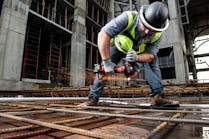Concrete construction has been a key factor at Georgia's new Gwinnett Braves minor league baseball stadium, set to open soon north of Atlanta. When the Richmond Braves, the Triple-A minor league baseball team of the Atlanta Braves, announced its move from Richmond, VA, to Georgia's Gwinnett County, there was a great deal of interest and excitement in the world of sports and for the citizens in Gwinnett County. Not only was the county getting its very own baseball team — the Gwinnett Braves — but a new $58.1-million stadium to house the team. The new stadium, with a capacity of 10,000, is located in Lawrenceville, GA, and is slated to become the focal point of a mixed-use entertainment district featuring new hotels, shops and restaurants. The stadium has been designed to have the "look and feel" of a historic ballpark. Features include high, thick, elevated slabs with deep beams and architecturally exposed columns and walls. One of the most unusual aspects of this stadium is the field layout. Although the structure itself will be a scaled down version of the major league stadium in Atlanta, the field layout will have the same dimensions as the larger stadium. This will allow the minor league ball players to play on a standard size field, grooming them for possible advancement to the major leagues. The concrete contractor, Precision Concrete Construction, Inc., faced a fast-paced construction schedule. Work started in June 2008, and the schedule called for completion opening day in April 2009. Precision worked with Doka to select the shoring and formwork used on the project. According to J.C. Thomas, Doka's account manager for the stadium project, Doka supplied approximately $2.5 million worth of shoring and formwork, including framed formwork Framax and Frami column forms, as well as Dokaflex S, a flexible hand-set system for floor slabs. "Our Lawrenceville, GA, branch was only a few miles from the worksite," Thomas said, "making deliveries extremely quick and easy. The close proximity also allowed our design team to provide faster turnaround on last minute design changes." "Last-minute" design and construction changes are typical for most project sites, but when a schedule is so tight, changes can be especially significant. Doka's forming equipment also helped the contractor to meet the aesthetic design challenges of the stadium. The outside façade of the stadium features large, exposed concrete columns. Using Doka's Frami forming equipment, the contractor was able to construct columns that met the designer's requirement for an architecturally appealing concrete structure. The concrete would be water-blasted and painted, which required a smooth and flawless finish. Doka Frami and Framax systems were used to form the more than 100 columns on the project. Frami was used on columns up to 32 inches by 32 inches square by 18 feet tall, while Framax was used to form 48-inch by 48-inch square by 24-feet tall columns. Safety on the jobsite was a major priority for both Doka and Precision Concrete. Thomas was especially impressed with the contractor's attention to the details of a safe worksite. "Although we had safety meetings every morning before the workday started, which is typical for most projects," noted Thomas, "the contractor also held frequent daily meetings during lunch breaks to make sure that safety procedures were up-to-the-minute."
Author Information
Anita LaFond is senior editorial manager for Constructive Communication and writes about a variety of technical subjects.




